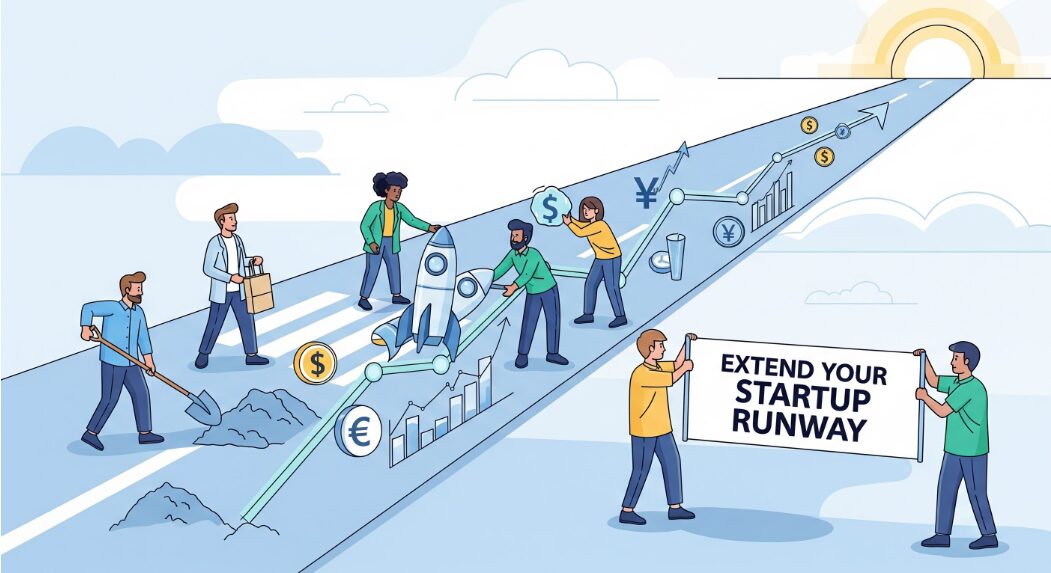Leveraging tactical ways to extend your startup runway is a founder superpower that can ensure the company’s long-term success. Running out of cash is one of the primary reasons why startups fail. But if you can avoid this pitfall, you’ll set the business up for stability and long-term growth.
Statistics indicate that 29% to 38% of startups go out of business because of inefficient financial management. And the inability to raise funding in time. This percentage rises as the company matures and reaches its fifth year. This is why founders must closely monitor their cash burn rate.
You’ll also run estimates for how long your cash reserves will last before operations must shut down. In short, how long the cash runway lasts. Next, you’ll work out how to extend this runway and stretch every dollar until you can successfully raise funding. Let’s do a deep dive into how that works.

*FREE DOWNLOAD*
The Ultimate Guide To Pitch Decks
Understanding What is Cash Runway
Simply put, your cash runway is the number of months the startup can continue operating at its burn rate. Or, at its current operational spending rate. This figure becomes even more crucial for nascent startups that have not yet started generating revenue.
These companies must rely on their founders’ bootstrapped money and support from friends and family. You’ll calculate the cash runway by dividing the total available cash by the total monthly expenses. Available cash is the cash in reserve that you can quickly access to cover costs.
However, this cash runway cannot include cash you could raise at the end of an ongoing funding campaign. Understanding how the cash runway works is a crucial aspect of budgeting expenses and cash flows. You’ll also need these figures when designing an effective fundraising strategy.
Estimating cash in reserve is crucial when planning the timeline within which you need money in the bank. That’s how you’ll successfully balance the startup’s growth milestones with financial stability. You’ll source data from its financials to align estimates with reality.
By adopting tactical ways to extend your startup’s runway, you’ll ensure its survival. It will also benefit from the flexibility to reach its projected milestones and refine the product to match buyer needs. Most importantly, you’ll have enough time to secure funding from external investors.
As expert fundraising consultants advise, you should have a 12-month runway remaining when you organize fundraising campaigns. That’s the time frame most companies need to close a round successfully and get money in the bank.

Raise Capital Smarter, Not Harder
- AI Investor Matching: Get instantly connected with the right investors
- Pitch & Financial Model Tools: Sharpen your story with battle-tested frameworks
- Proven Results: Founders are closing 3× faster using StartupFundraising.com
Calculating Runway
The first crucial lesson in tactical ways to extend your startup runway is knowing how to calculate it accurately. Keep in mind that most founders miscalculate their runway. Their figures can sometimes vary by 20% to 30% due to several variables that affect cash flows.
As mentioned earlier, you’ll determine the cash runway by dividing the company’s cash balance by its net burn rate. Accordingly, this is what you get:
Cash Runway = Current Cash Balance / Net Burn Rate
Here,
Net Burn Rate = Monthly Cash Expenses – Monthly Cash Revenue
For example, the cash reserves total $20M, and you determine a $0.5M burn rate. In that case, you have a runway of 40 months. That’s the time frame for which you can continue operating before needing a capital infusion. Here are some of the variables that can influence your calculations.
- When you’re planning a fundraising campaign, a good metric to determine is the number of months of runway you have. However, companies may experience unusual cash inflows and unexpected expenses. In that case, you could consider a quarterly or annual runway.
- Add up all the expenses that are unlikely to change—for instance, rent, utilities, payroll, taxes, research and development, and insurance. Even if you don’t pay some of them each month, you should calculate the per-month expense. Keep a close watch on the debt you’ve taken. A debt of even $5M ultimately translates into a 50% shorter runway.
- Add up all the revenue you’re confident of generating—for instance, services, sales, and any other sources. Again, calculate the per-month revenue.
- When calculating the cash in reserve, you’ll add up liquid cash, such as a bank balance and any other assets. You should be able to convert these assets into liquid cash within a reasonable time, like 30 days.
- Your cash runway should factor in the capital investments and other major expenses you’ll incur to support and grow the company.
Having an extended runway, a robust P&L statement, and lean operating approaches are only a few of the top reasons why startups succeed. If you would like to learn more, check out this video I have created.
Tactical Ways to Extend Your Startup Runway – Start with a Detailed Analysis
To accurately predict the runway, ensure the metrics you’re using are accurate as well. And that means understanding exactly where the company stands. Start by scrutinizing the profit and loss (P&L) statement, and break each component into small parts. Here’s what you’re looking at:
- Every expense, big and small, including cash and credit payments.
- Each incoming cash, including liquid and credit.
- If you see a loss, determine its source.
- Analyse expenses to identify efficient and inefficient spending. In other words, which dollars yield actual growth, and which are wasteful and can be eliminated.
When analyzing the loss/costs, sort them into gross margins and opex (operational expenses), including compensation opex and non-compensation opex. Here are the questions you should ask:
- What are the compensation OPEX, such as employee wages, benefits, and commissions? You’re basically looking at the costs of labor.
- What are the non-compensation OPEX, such as marketing, rent, utilities, and any other costs essential to run the core operations? This figure can also include computer hardware leases, hosting, subscriptions, and any others.
Next, you’ll create a roadmap for executing the runway extension. This step won’t be easy, since it involves cutting back on non-essential costs and lowering the burn rate.
You’ll identify each cost and estimate the impact of eliminating it. This action will help you create a roadmap for your execution. Don’t lose sight of the end goal–to extend the runway. To make that happen, you’ll set up milestones, such as making the company’s cash flow positive.
Remember that a robust P&L statement is a crucial asset in your pitch deck. When investors scrutinize cash flows and runway, they are more likely to offer capital on favorable terms. Ultimately, your objective is to raise a funding round.
Improve Revenue Streams
One of the most effective tactical ways to extend your startup runway is to increase revenue and incoming cash. Here’s what you need to do:
- Boost sales with aggressive sales and marketing programs that can quickly generate income.
- Target existing customers and entice them to make more purchases by offering complementary products and services. You’ll also ramp up your efforts to close ongoing deals. Remember that retaining existing buyers is more cost-effective than acquiring new ones.
- Target new customer segments within and outside of your geographical location and other demographics.
- Run limited-time promotional campaigns and offer significant discounts on early bird orders. You’ll also offer incentives for long-term contracts and upfront payments. Discounts on bulk orders and early payments are another effective strategy.
- Adopt new monetization tactics, such as subscription models and multi-tier pricing. Offering free plans with limited features also works well. Customers can use the product before purchasing subscriptions.
- Enter into partnerships with affiliate marketers and tap into cross-selling opportunities. These collaborations will help expand your market reach while building up the brand’s credibility.
Optimize Your Pricing Structure to Edge Out the Competition
Another of the tactical ways to extend your startup runway is to analyze your pricing structure relative to competitors’ products. You’ll also identify customer churn rates to determine the drivers. Do you need to get more competitive vis-à-vis pricing? Or, are your products offering more value?
Are you offering exceptional features that buyers will be willing to pay more for? In that case, you could be leaving money on the table, which could contribute to extending your runway. Start by making minor adjustments while gauging market reaction, preferably by introducing new features.
Make sure your new pricing structure reflects the value you’re offering. Your target should be a 5% to 10% price hike to improve profits and, ultimately–the runway. Higher prices contribute to higher profits, which feature well on the financials slide of your pitch deck when raising funding.
Keep in mind that storytelling is everything in fundraising. In this regard, for a winning pitch deck to help you here, take a look at the template created by Peter Thiel, Silicon Valley legend (see it here) that I recently covered. Thiel was the first angel investor in Facebook with a $500K check that turned into more than $1 billion in cash.
Remember to unlock the pitch deck template that founders worldwide are using to raise millions below.
Optimize Costs to Lower the Burn Rate
Here’s where your earlier cost analyses come into play. You’ll use the results to sort through fixed and variable costs. Next, you’ll eliminate the expenses that don’t directly contribute to growth and survival. Experts recommend targeting the top 20% of your costs with the highest impact on cash flows.
If your runway is 12-24 months, you’ll focus on aggressive, rapid cost optimization. Here’s what you need to do:
- Identify and cut non-essential operational spending. Even a 10% to 15% saving can go a long way.
- Work on improving operational efficiency by lowering waste and streamlining workflows.
- Revisit your hiring strategy and pay co-founders a lower salary temporarily to ease the cash crunch.
- Renegotiate terms with vendors, suppliers, service providers, and distributors. Ask for lower prices and favorable contracts. You can also shop around for cheaper partners.
- Cut back on unnecessary overheads, such as unused office space and software subscriptions. A lean approach and capital efficiency look good on a pitch deck.
- Analyze high-cost ongoing marketing campaigns to identify those delivering real results. You can stop the ones that aren’t working well.
Look for Funding Sources to Bridge the Gap
Funding campaigns are time-consuming and you can’t risk the company reaching cash-zero. Look around for short-term loans, like bridge financing, to cover the shortfall. Reach out to your existing investors and explain the circumstances. Remember that they appreciate transparency.
Experienced, market-savvy investors are valuable strategic partners and can guide you on how to extend your runway. In addition to a cost-efficient game plan, they may also assist you with advances and venture debt. You could also leverage business credit cards and revenue-based financing.
Whatever the short-term capital sources you tap, your stress should be on non-dilutive capital. Talk about returning the loans once you successfully close the next funding round.
Outsource Contract Tasks to Specialized Teams
Maintaining in-house teams for different tasks can be expensive, as you’ll also incur overheads such as salaries and office expenses. Consider outsourcing these tasks to specialized teams on a contract basis rather than hiring full-time employees. For instance, building a minimum viable product (MVP).
You could also hire talent to develop additional features for the MVP. Here’s another of the cost-effective tactical ways to extend your startup runway. Visit professional websites like LinkedIn, Upwork, Fiverr, and Freelancer.com to hire freelance contractors worldwide.
Not only can you shop around for the best talent, but you can also get competitive pricing. Aside from product development tasks, you can also hire offshore teams for marketing, customer support, customer acquisition, and virtual assistance.
These highly qualified professionals typically charge 30% to 50% lower rates than contractors in North America and Europe. Most importantly, you can leverage the flexibility they offer thanks to hourly contracts. You can also scale up or down as the company’s needs evolve.
Don’t Lose Sight of Sustainable Growth
Working on tactical ways to extend your startup runway should balance strategic spending for growth with a lean, measured approach. Don’t hesitate to allocate resources to projects likely to yield a high return on investment (ROI). But cut back on avoidable costs.
Outsourcing tasks and keeping in-house staffing low are good practices. But the trade-off should not be losing out on top talent for the company. You’ll also ensure an ideal product-market fit before aggressively scaling the company.
Extending your startup’s runway is about making strategic financial decisions that promote growth while keeping costs down. You’ll lower costs while also strengthening your product portfolio to sustain your customer base and market presence.
Focus on building a cash cushion by optimizing your pricing structure while also ensuring your brand remains competitive. Don’t lose sight of the endgame–remain operational and scale until you can raise funding successfully.
Keep in mind that the longer the startup runway, the higher the valuation will be when you approach investors. You can take your time selecting the right investors and term sheets that offer terms and conditions favorable to the company.
You may also find our free library of business templates interesting. There, you will find every single template you need to build and scale your business completely, all for free. See it here.





Facebook Comments